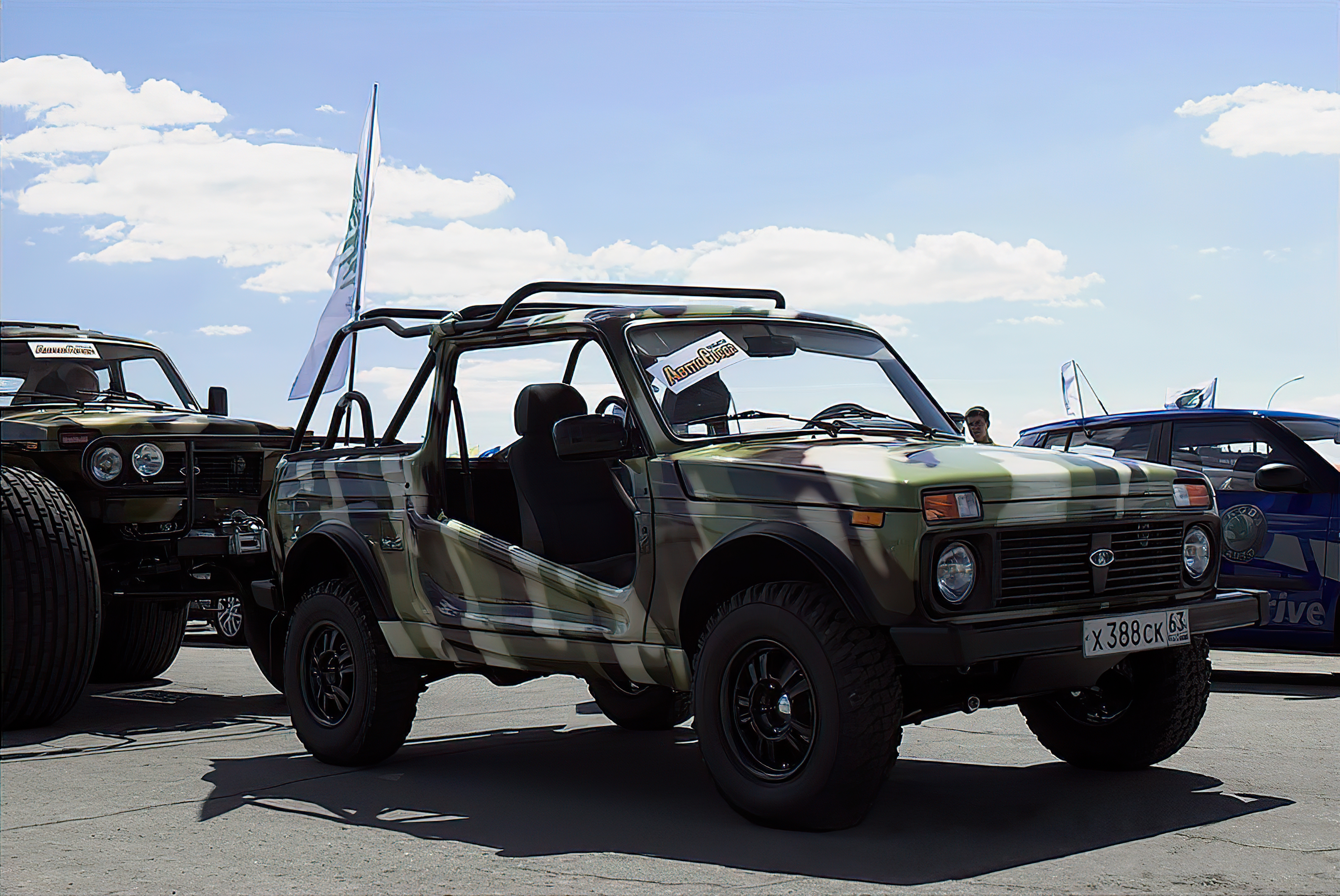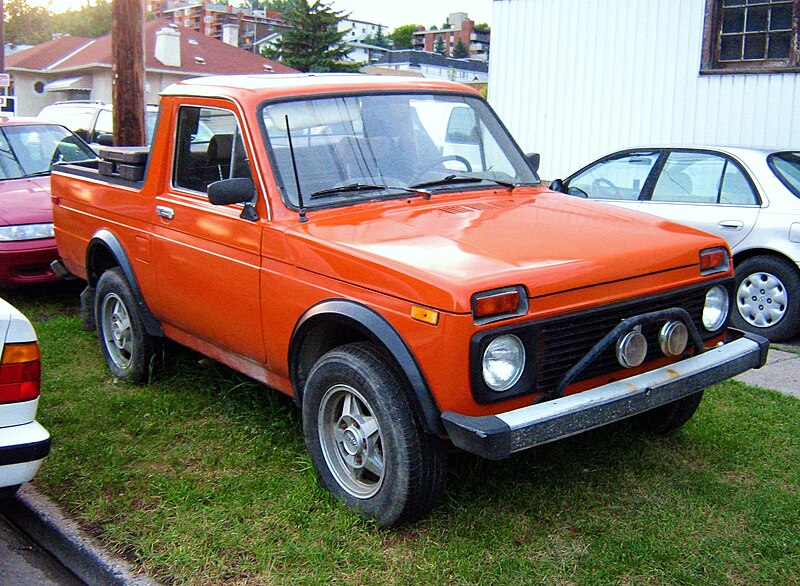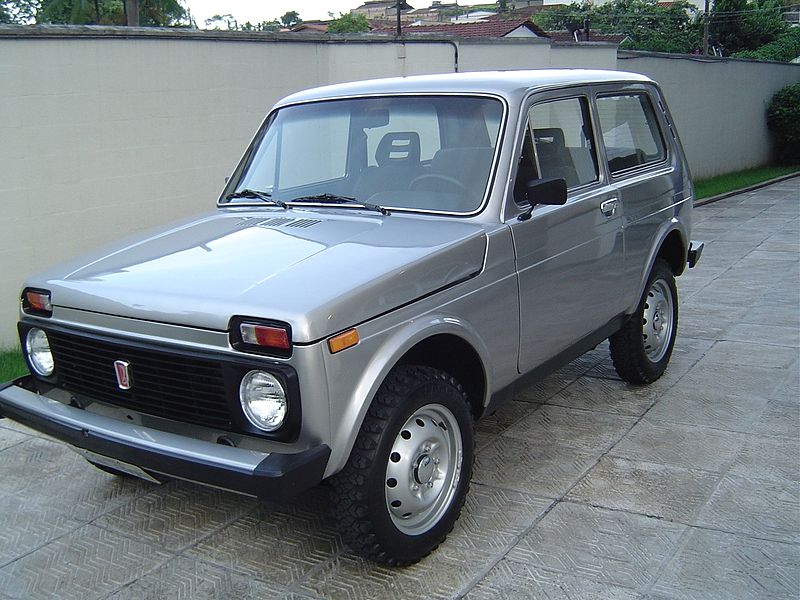The LADA 4x4, formerly called the Lada Niva (Russian: Лада Нива; Niva (нива) is the Russian word for "field"), is an off-road vehicle designed and produced by the Russian (former Soviet) manufacturer AvtoVAZ specifically for the rural market.
It was the first mass production off-road vehicle to feature a unibody architecture, independent front suspension with coil springs, and is a predecessor to current crossover SUVs which nearly all follow this format; it inspired the Suzuki Vitara. Like the Vitara, the Lada 4x4 uses a recirculating ball truck steering box for off-road reliability. Pickup and emergency van versions are produced by VAZInterService.
The LADA 4x4 was formerly called the Lada Niva. The name change occurred after the Niva brand was transferred to General Motors, though AvtoVAZ retains the rights to the equivalent Cyrillic name, 'Нива'. It was also marketed as the Lada Sport in Iceland, Lada Taiga in Austria, Bognor Diva in Uruguay, the Lada Cossack in the United Kingdom. Since 2014 it has been sold as the LADA 4x4 in Russia, a name which is also beginning to replace "Niva" in export markets.
Cossack
During the 1980s local Lada importers in various markets made their own upgrades to help compete with more modern SUVs. In the UK the Cossack model featured large body decals, roof rails, running boards, 15" alloy wheels, and on some versions a sunroof, steel bullbars, spotlights, a rear-mounted spare tyre and semi-bucket seats. Other markets' importers made similar upgrades and many were also called Cossack.
VAZ-2122 Reka
Although the VAZ were meant exclusively for production of passenger cars and thus, the Niva was intended to be a strictly civilian vehicle, the Soviet military was truly astonished by its fascinating offroad capabilities so that it ordered its military version to be created from VAZ, which could replace the currently used UAZ-469 as standard military 4x4 vehicle. In 1976, when VAZ-2121 development was almost finished, engineers from Tolyatti began working on an amphibian off-roader, which became known as VAZ-2122 Reka ('River'), using completely different and, naturally, tougher body of a usual military vehicle (with a classic feature of spare wheel located on the back of the body instead in the engine compartment like on a classic Niva) in combination with ordinary Niva chassis and wheels, together with its permanent four wheel drive system (transfer case and lockable central differential) and mechanics in general, which was intended to be sold to the Soviet Ministry of Defense. Despite having a more rugged body, it weighted approximately as same as the usual Niva, however, instead of 1,600cc (55kW/75 hp) VAZ-2106 engine which Niva had, it used older and less powerful 60 hp (45 kW; 61 PS) 1,300cc engine derived from VAZ-2101 instead, with a lower top speed of 71 mph (114 km/h) on road or 5 kn (5.8 mph; 9.3 km/h) on water. Internally, it featured a different, metallic front panel, although it used the same Niva instruments along with the same steering wheel and artificial leather seats.
LWB Nivas
Long-wheelbase versions - the five-door VAZ-2131 and three-door VAZ-2129 - were also produced .
from 1994, but not generally exported.
Uses of the Niva
In Russia and Europe the Niva has been used as an ambulance, a military vehicle, and by various police forces and utility companies. It also saw service for a time as a vehicle for lifeguards on beaches in the Netherlands. In former Czechoslovakia, the Niva was used as a standard police car of their Militsiya. Croatian Army was notable as being the only army which used Nivas (taken from civilians) as their standard military 4x4 vehicle during the war of 1990s due to serious lack of proper military vehicles such as UAZ-469 or GAZ-69 (which were also in use), until it was later replaced by British Land Rover Defender and Austrian Steyr Daimler Puch, which are still being used today.
Chevrolet Niva
GM-AvtoVAZ, a joint venture between AvtoVAZ and General Motors, produces the Chevrolet Niva. (previously known as VAZ-2123 Niva in domestic market). It features an updated body and 1.7-litre gasoline engine with fuel injection. Although the body and the interiors are new, it is still based on the old VAZ 2121 engine, transmission and most mechanicals. Its off-road ability is exemplary compared with many modern budget SUVs, having been designed for tough tundra territory.
Long versions
VAZ-21218 "Fora"
VAZ-212183 "landole" (Lan-doe-lay)
VAZ-212182 "Force"
VAZ-2129 ("Cedar")
VAZ 2129 "Utiliter"
VAZ-2130 ("Cedar")
VAZ-2131 (LADA 4x4 5-doors.)
VAZ-2131 SP (213105/213145)
VAZ-213102
VAZ-2121 sugar
VAZ-21317









.jpg/1024px-Lada_Niva_(VAZ_2121).jpg)

.jpg/1024px-Integrated_Safety_and_Security_Exhibition_2011_(363-47).jpg)





.jpg/1024px-BDtT-4M_on_MIAS_2016_(front_view).jpg)





.jpg/800px-VAZ-2121_customized_to_cabriolet_(side_view).jpg)


.jpg/800px-Capbreton%2C_Landes_-_France_(4995616164).jpg)


.jpg/1024px-Integrated_Safety_and_Security_Exhibition_2009_(195-2).jpg)
.jpg/1024px-Integrated_Safety_and_Security_Exhibition_2011_(363-48).jpg)





.jfif)


No comments:
Post a Comment